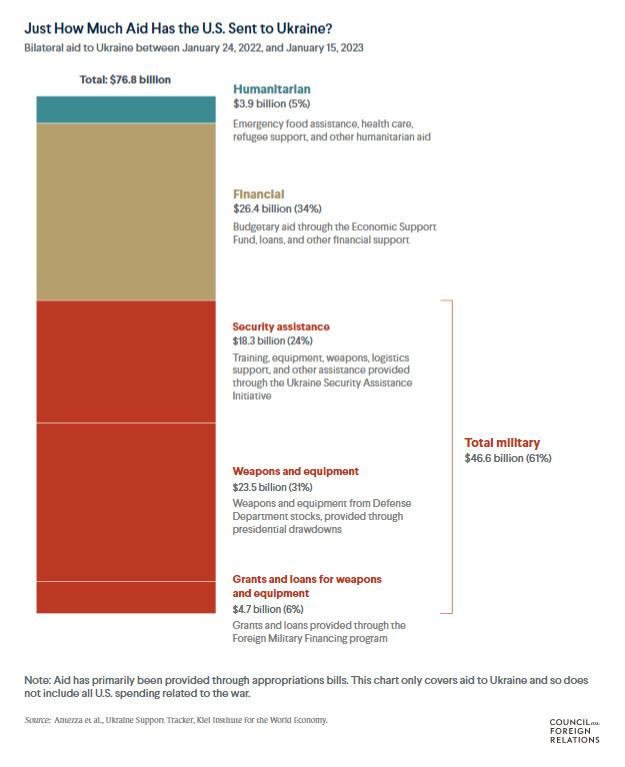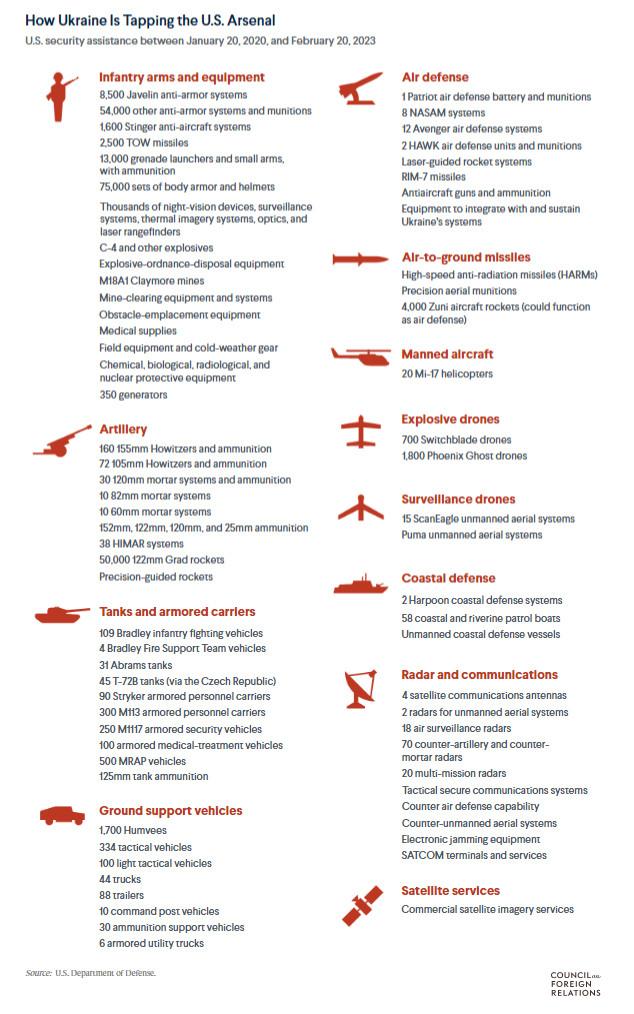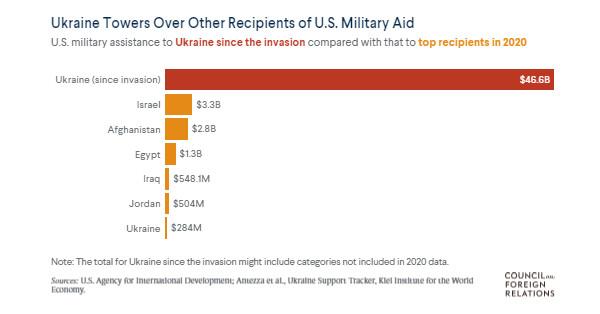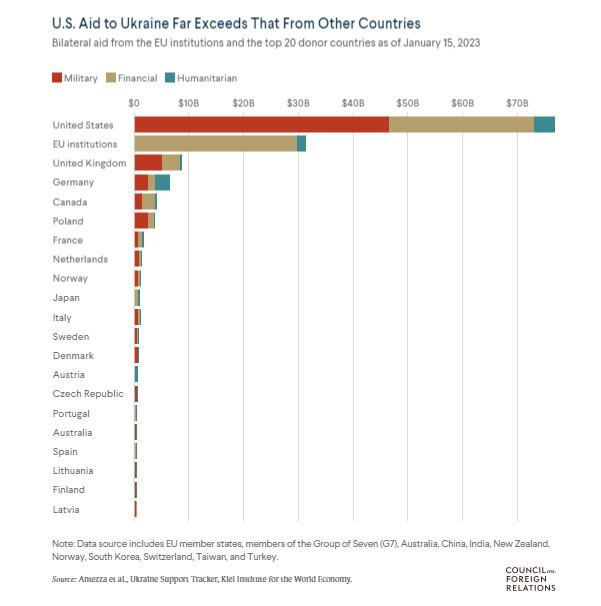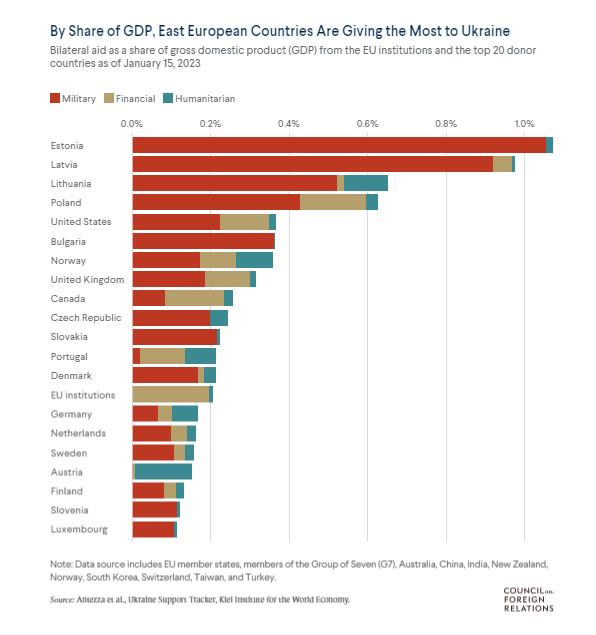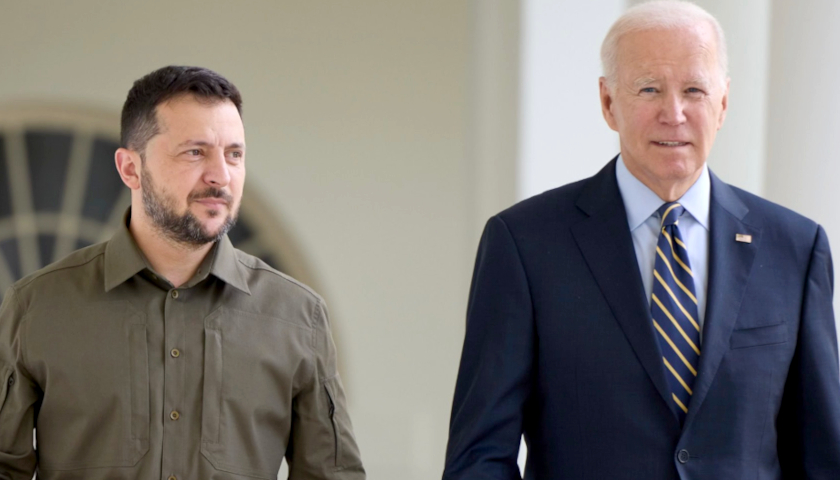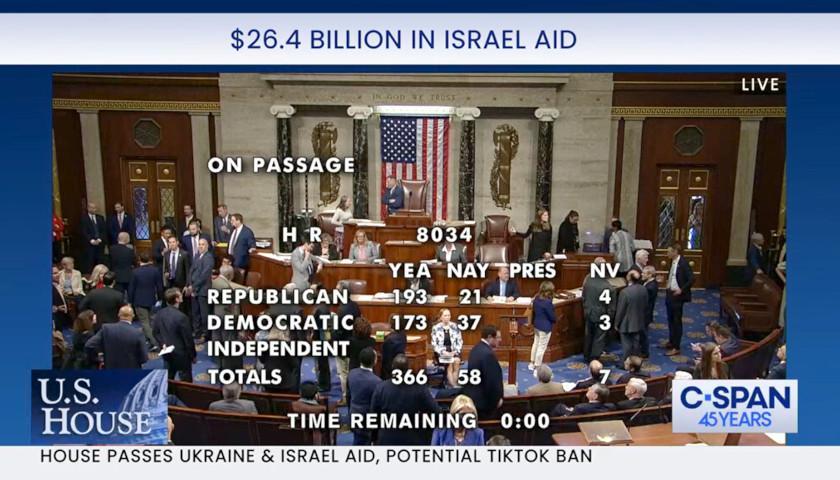by George Rasley
According to a report by Jonathan Masters and Will Merrow, since Russia’s invasion in February of 2022, Ukraine has become far and away the top recipient of U.S. foreign aid. It’s the first time that a European country has held the top spot since the Harry S. Truman administration directed vast sums into rebuilding the continent through the Marshall Plan after World War II.
Since the war began, the Biden administration and the U.S. Congress have directed about $75 billion in assistance to Ukraine, which includes humanitarian, financial, and military support. The number is documented in a report by the Kiel Institute for the World Economy, a German research institute, analyzed by Masters and Merrow.
The historic sums are helping a broad set of Ukrainian people and institutions, including refugees, law enforcement, and independent radio broadcasters, though most of the aid has been military-related. Dozens of other countries, including most members of the North Atlantic Treaty Organization (NATO) and the European Union, are also providing large aid packages to Ukraine, reported Masters and Merrow.
However, the Kiel Institute for the World Economy study might be a little behind in calculating the total American commitment to Ukraine. According to USA Today, more than $100 billion in U.S. weaponry and financial aid have flowed to Ukraine in less than a year, a number that doubles Russia’s $48 billion annual military budget and means the United States has already gifted Ukraine military equipment valued at more than the entire annual military budget of Australia.
USA Today reports the Pentagon spent $62.3 billion in 2022 on Ukraine for weapons, ammunition, training, logistics, supplies, salaries and stipends, according to the Joint Strategic Oversight Plan for Ukraine Response report. Inspectors general for several agencies released the report in January.
The State Department and U.S. Agency for International Development spent another $46 billion for activities ranging from border security for Ukraine to funds for basic government services such as utilities, hospitals, schools and firefighting. Other government agencies, including the Department of Agriculture, spent another $5 billion.
Ukraine has requested certain advanced equipment, such as fighter aircraft, that the United States and other donor governments have been unwilling to provide, worried that doing so could escalate the war. Despite the reluctance to provide advanced aircraft, Masters and Merrow report at the one-year mark of the war, the Biden administration had provided or agreed to provide Ukraine with a long list of defense capabilities, including Abrams battle tanks, anti-aircraft missiles, coastal defense ships, and advanced surveillance and radar systems.
When compared with the U.S. military assistance to other top recipients, including Afghanistan and Israel, Masters and Merrow observe the extraordinary scale of this aid comes into view.
This chart from the Masters and Merrow article shows that when compared with the critical support to Ukraine from other countries, the magnitude of U.S. aid stands out.
Or viewed another way.
This final chart from the Masters and Merrow article, however, shows that in terms of the relative size of their economies, countries closest to the fighting, particularly those that have experienced Russian occupation during the Soviet era, such as Latvia, Lithuania, Estonia and Poland – who are all too familiar with Russian brutality and Putin’s “Eurasianist National Bolshevism” ideology – have exceeded the United States.
The European Union contributions have been a sore point with many Americans, who argue that the Europeans, who would be next in Putin’s sights should he prevail in Ukraine, aren’t doing enough to protect themselves.
Another analysis of the Kiel Institute on the World Economy numbers suggests a more nuanced view is needed to really understand the disparity in contributions. According to an article by Thomas Kleine-Brockhoff and James H. Sallembien in the euobserver.com, the European Union and its member states actually contributed slightly more to Ukraine than the US did last year.
US contributions approximated €48bn (a little over $51 billion) through 20 November, 2022, while commitments from the EU and its member states reached close to €52bn (over $55.5 billion).
These included €34.7bn (a little over $37 billion) in financial support, which covered €17bn (a little over $18 billion) for Ukrainian refugees, €11.7bn (a little over $12.5 billion) in military assistance, and €5.4bn (a little over $5.7 billion) in humanitarian aid.
If you remove refugee costs from European contributions, suddenly, the balance tilts irredeemably towards the US. Of course, to a European, particularly one living in Poland or the Czech Republic, where Ukrainian refugees currently represent more than four percent of the national population, this omission would seem off-putting at best observed Kleine-Brockhoff and Sallembien.
The problem in demanding that the Europeans match the United States in military contributions is that Ukraine fires between 5,000 and 7,000 artillery rounds per day, an amount no European industry can match.
Only the United States military-industrial complex can sustain that level of production. And Washington plans to increase production from 14,000 rounds per month to 20,000 by the spring, which would still only cover less than a week of Ukraine’s needs. That’s what the entire French army ordered between 2015 and 2020 for its Caesar howitzers, reported Kleine-Brockhoff and Sallembien.
One final data point, Ukraine is generally acknowledged to have around 500,000 military personnel, of which about 300,000 are combat troops. If we divide the $100 billion top estimate of US aid by the entire Ukrainian military force it works out to around $200 million per Ukrainian soldier, and $333.333 million per combatant. That is an astonishing number, considering that the top-line American fighter, the F35 tops out at about $90 million per copy.
If we are giving enough aid to Ukraine to equip every Ukrainian soldier with three F35s it seems the least Congress could do is audit the aid given so far. The Capitol Switchboard is (202) 224-3121 we urge CHQ readers and friends to call their Representative and Senators to tell them it is past time for Congress to exercise its Article I constitutional war powers and power of the purse by conducting an audit of American aid to Ukraine.
We leave it to readers to decide if American taxpayers should fund Ukraine’s border security, utilities, hospitals, schools and firefighting, while leaving America’s southern border wide open and our infrastructure crumbling.
Original charts are found at https://www.cfr.org/article/how-much-aid-has-us-sent-ukraine-here-are-six-charts. Yes, before you complain, we know it is from the globalist Council on Foreign Relations, but the data for the charts is from an independent source, which has a good track record.
– – –
George Rasley is the CEO and Editor of ConservativeHQ.
Photo “U.S. Capitol” by Leandro Paes Leme.



